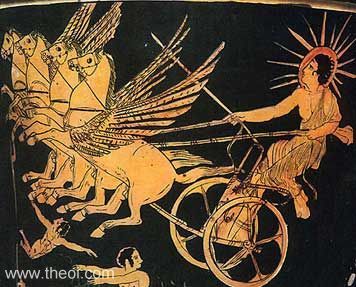Original French:
Tombera du ciel un feu qui apparoistra en plusieurs païs & brulera quelque palais: le feu sera grand. A la fin de ceste Lune & une partie de l'autre, l'on doubtera en plusieurs païs la conflagration de Veseve ou de Phaethon revenir une autre fois. Combien qu'une partie de son feu est à venir infailliblement 1607.
English Translation:
A fire will fall from the sky which will appear in several countries and will burn some palace: the fire will be great. At the end of this Moon and one part of another, one will doubt in several countries the conflagration of Vesuvius or Phaethon to come again one other time. However one part of its fire is to come infallibly in 1607.
What this statement shows is that Nostradamus will occasionally drop a prophetic statement inside of these almanacs, which are for the most part worthless in terms of knowing the future. Phaethon is a mythological reference to a comet: as a son of Helios or Apollo (god of the Sun), Phaethon desired to ride the Sun's chariot for a day. As the myth goes, Phaethon lost control of the Sun's chariot and got to close to the earth which started to burn. Zeus intervened and struck down Phaethon with a thunderbolt, who then fell from the sky into the river Eridanus.

So what happened in the year 1607? This particular year is mentioned by Nostradamus in some of his other quatrains. In that year something very curious happened: in the year 1607 the comet we now know as Halley's comet made one of its periodic passes close to the earth. Halley's comet is the most famous of all comets, and passes by the earth every 75-76 years. The astronomer Edmond Halley recognized that this comet, which appeared in 1682, was similar in appearance to the comet that appeared in 1531 and 1607, and predicted its return in the year 1758. Since he was supposedly the first to recognize this, the comet was named after him. But Nostradamus beat him to it: he knew that infallibly a comet would return in 1607!
The question now is, how did Nostradamus do this? Like Edmond Halley, he probably had references to other observations of this comet, and thus concluded it would appear in 1607. Nostradamus lived during its appearance in 1531, which was also observed by the astronomer Petrus Apianus of his day. Petrus Apianus was widely published, was a favorite of Emperor Charles V, so it is likely Nostradamus read his writings. Quite likely Nostradamus knew this from astronomy, so unlike his other statements he marked this one as "infallible" - he made an astronomical calculation of his own, over 150 years before Edmond Halley. And you heard it first from me - I am not aware of anyone having noticed this statement in this almanac of Nostradamus. So perhaps we need to rename Halley's comet to the comet of Nostradamus: our history books got it wrong. Edmond Halley happened to have published the first scientific observation, but now we know that at least Nostradamus knew that this comet was to return again in 1607.
In addition to the comet of Phaethon, Nostradamus mentions the fire of the volcano Vesuvius in Italy. Comets can be predicted with accuracy, but volcanic eruptions can not. Vesuvius most famous eruption was that of 79 A.D. which buried the city of Pompey. By the time of Nostradamus, Vesuvius had been an inactive volcano since the 13th century. However, in 1631 A.D. Vesuvius erupted anew, ending its long period of silence and killing about 3,000 people. Since then it has been an active volcano. This new beginning of volcanic activity was close to the appearance of "Halley's" comet in 1607 A.D., as Nostradamus predicted.














No comments:
Post a Comment
Comments, questions, corrections and opinions welcome...